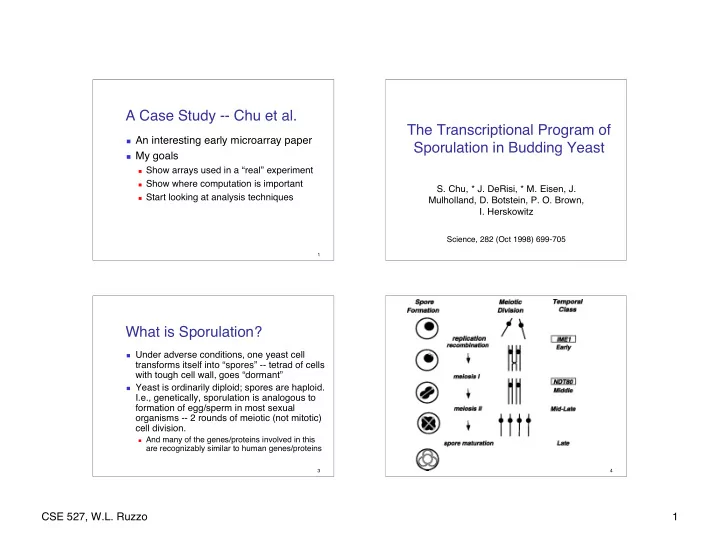

A Case Study -- Chu et al. The Transcriptional Program of An interesting early microarray paper Sporulation in Budding Yeast My goals Show arrays used in a “real” experiment Show where computation is important S. Chu, * J. DeRisi, * M. Eisen, J. Start looking at analysis techniques Mulholland, D. Botstein, P. O. Brown, I. Herskowitz Science, 282 (Oct 1998) 699-705 1 What is Sporulation? Under adverse conditions, one yeast cell transforms itself into “spores” -- tetrad of cells with tough cell wall, goes “dormant” Yeast is ordinarily diploid; spores are haploid. I.e., genetically, sporulation is analogous to formation of egg/sperm in most sexual organisms -- 2 rounds of meiotic (not mitotic) cell division. And many of the genes/proteins involved in this are recognizably similar to human genes/proteins 3 4 CSE 527, W.L. Ruzzo 1
The Chu et al. Experiment Measures of Sporulation Measure mRNA expression levels of all 6200 yeast genes in 7 time points (0-11 hours) in a (loosely synchronized) sporulating yeast culture Compare level at time t to level at time 0 on 2-color cDNA array Plus some more standard tests as controls NB: < 20% spores, so data are mixtures of cell stages 5 6 Standard Test (Northern) vs Array Prototype Expression Profiles 7 8 CSE 527, W.L. Ruzzo 2
"Sporulation" Summary, I What they did: measured mRNA expression levels of all 6200 yeast genes in 7 time points in a (loosely synchronized) sporulating yeast culture plus some more standard tests as controls What they learned: 3-10x increase in number of genes implicated in various subprocesses several subsequently verified by direct knockouts further evidence for significance of some known transcription factors and/or binding motifs several potential new ones evidence for existence of others 9 10 "Sporulation" Summary, II More on Computation Where computation fits in Similarity Search -- given a loosely defined sequence “motif”, e.g. a transcription factor automated sample handling binding site, scan genome for “matches” image analysis “Which genes have an MSE element?” data storage, retrieval, integration E.g., weight matrix models, Markov models visualization clustering Motif discovery -- given a collection of More on these sequences presumed to contain a common sequence analysis topics later in pattern, e.g. a transcription factor binding site, similarity search the course motif discovery find it & characterize it structure prediction “What motifs are common to Early Middle genes?” E.g., MEME, Gibbs Sampler, Footprinter, … 11 12 CSE 527, W.L. Ruzzo 3
More on Computation Chu’s “Supervised” Clustering Hand picked ~ 40 prototype genes Finding groups of sequences that With significant variation in data set plausibly contain common sequence With known function motifs Hand-segregated into 7 groups (“Early”, …) E.g., clustering (co-varying because co- Assign all others to “nearest” group regulated?) Based on Pearson correlation to per-group averages of prototypes For visualization, order within groups by correlation to neighboring groups 13 14 2 warnings about Critique arrays & clusters Warning 1: + - expression data often do not separate into nice, compact, well-separated clusters Cf Raychaudhuri et al. (next 2 slides) 15 16 CSE 527, W.L. Ruzzo 4
17 18 2 warnings about arrays & clusters Warning 2: it’s hard to visualize high-dimensional data & inadequate visualization may obscure as well as enlighten Cf Next 2 slides. 19 20 CSE 527, W.L. Ruzzo 5
21 CSE 527, W.L. Ruzzo 6
Recommend
More recommend